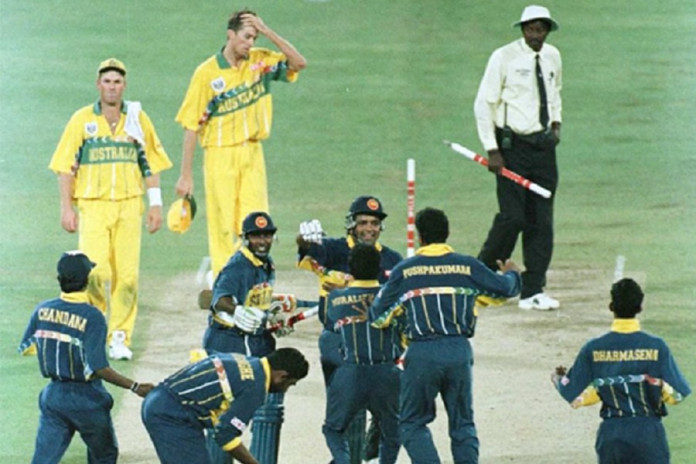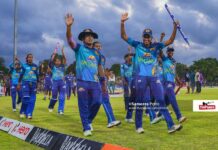It was time to rejoice, in the most cherished moment of Sri Lankan cricket. For a beautiful island devastated by an ongoing conflict, ‘Cricket’ was an answer. For a nation hampered by violence and political tension, the battle between the bat and the ball was a reason to unite.
It was in 1996, when a team of brave men reached the ‘Everest’ of cricket, ensuring that the night of 17th March will be a perennial memory for every Sri Lankan. The streets of Colombo, usually impeded by vicious explosions, were lit by fire crackers, the sounds of the Papare bands, flags and the vociferous sounds of people who kept their differences aside to celebrate the splendid triumph.
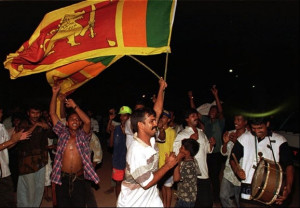
Coached by Dav Whatmore and led by the commanding “Captain Cool” Arjuna Ranatunga, the marginally rated team was fueled with solidity and consistency to beat some of the strongest sides en route to victory. The explosive top order was spearheaded by the opening salvos of Sanath Jayasuriya and Romesh Kaluwitharana yielding a new era for ‘pinch hitting’ while the duo was backed by Asanka Gurusinghe and Aravinda de Silva. In a period where, 50 or 60 was considered sufficient in the first 15 overs, they produced 117 against India, 123 against Kenya and 86 against India in the semi-final. Braced by Roshan Mahanama and Hashan Tillakaratne, the strong middle-order was led by the skipper himself. The bowling offence was headed by Chaminda Vaas, Pramodya Wickamasinghe, Kumar Dharmasena and Murali while Jayasuriya and de Silva’s nifty spin came in handy during key situations. The victory certainly changed the way cricket was played in the country, thus unveiling a dominant force in international cricket.
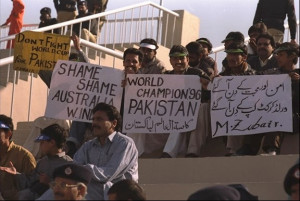
Controversy bewildered the tournament before any games were played as Australia and West Indies refused to play in Sri Lanka due to security reasons. In response, Sri Lanka questioned the credibility of quoting security concerns when the ICC had already determined that it was safe. Following extensive negotiations, they decided to award both games to Sri Lanka on forfeit. As a result, Sri Lanka qualified for the quarterfinal even before a game was played.
Thrills and spills kick-start ’96
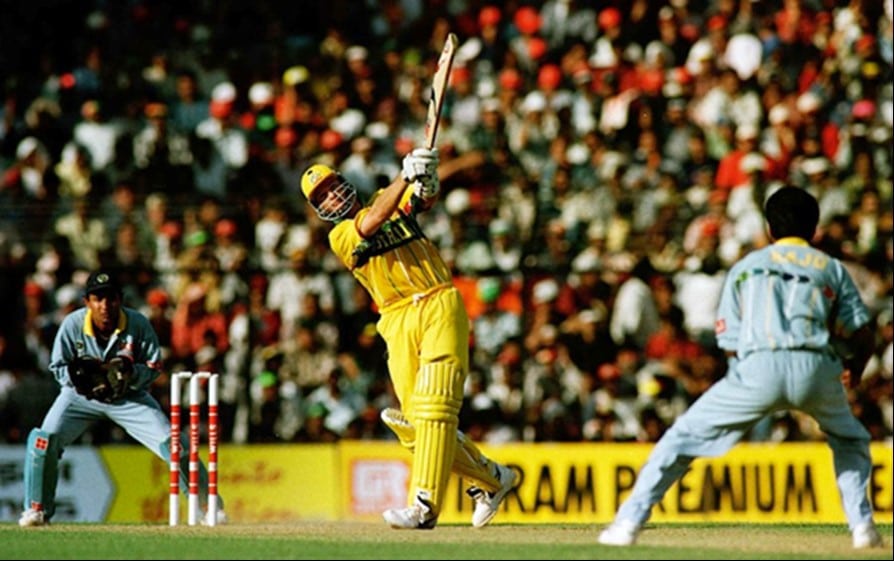
Mark Waugh’s consecutive tons, Alan Donald’s near-fatal blow and Kenya’s humbling of West Indies all were in the parcel of the group stages.
Waugh’s back to back tons in Visakhapatnam and Mumbai against Kenya and India respectively, made him the first to score consecutive centuries in the World Cup.
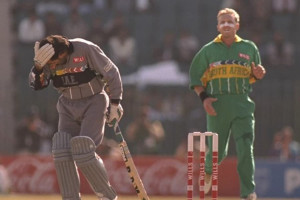
At Rawalpindi, Gary Kirsten’s 188 pummeled UAE in a game that was remembered for the ‘White Lightning’ which struck the UAE skipper Sultan Zarawani on the head, as he dared to walk in to face the fastest bowler in the world wearing just a floppy hat.
Minnows Kenya shocked the entire world by beating the two time World Champions West Indies by 73 runs at Pune.
A ‘Pinch-hitting’ Rampage Shambles India
After a convincing 6-wicket win against Zimbabwe, Sri Lanka came up against India at Delhi on the 2nd of March. Winning the toss, Sri Lanka chose to field with India posting an impressive 271/3, thanks to Tendulkar’s run-a ball 137 which was also his personal best. The imposing target looked trivial when openers Sanath Jayasuriya and Romesh Kaluwithrana
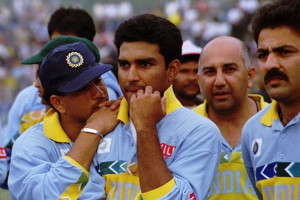
commenced their riot on the Indian bowlers. The duo hammered 42 in their first 3 overs, snatching 22 off Manoj Prabhakar’s second. When Prasad removed Kaluwitharana for 26, Sri Lanka were already 53 in 5 overs. Jayasuriya continued his assault with Gurusinghe as they scored 117 during the field restrictions. He lowered his gear before getting out to Kumble for 79. But with the initial damage done, it was up to Ranatunga and Hashan Tillakaratne to bat patiently, which they did with a 131-run stand to see the Lankans home.
‘Mad Max’ Illuminates Asgiriya
On the 6th of March, Sri Lanka, who had already assured their top position in Group A, hosted Kenya at Asgiriya in what turned out to be a record-breaking encounter. Kenya, who returned after a historical win against West Indies, were planning to cause another upset while the Lions were eager to show that they would have scored maximum points even without the walkovers. They seized a bag of records, especially scoring 398/5, an ODI record for the highest team score. Jayasuriya and ‘Kalu’ began the carnage with 83 runs that came in a mere 40 balls. Odumbe dismissed both in quick successions but Aravinda de Silva teamed up with Asanka Gurusinghe to add 183, Sri Lanka’s best partnership in ODIs. One of Gurusinghe’s mammoth sixes traveled to the surrounding hills and the lost ball was forced to be replaced. At his departure for 84, Ranatunga joined ‘Mad Max’ Aravinda to pile the misery on the Kenyans with a partnership worth 106. The innings saw Aravinda scoring the maiden World Cup century for Sri Lanka as he stormed to 145 in just 115 balls that featured 14 fours and 5 maximums. Ranatunga remained unbeaten till the end with his 75-run assault that came in 40 balls. The minnows refused to surrender as their resilient comeback saw Steve Tikolo falling a mere four runs short of a courageous century. However the target was too much for the Kenyans as they ended at 254/7, conceding a 144-run win to the hosts.
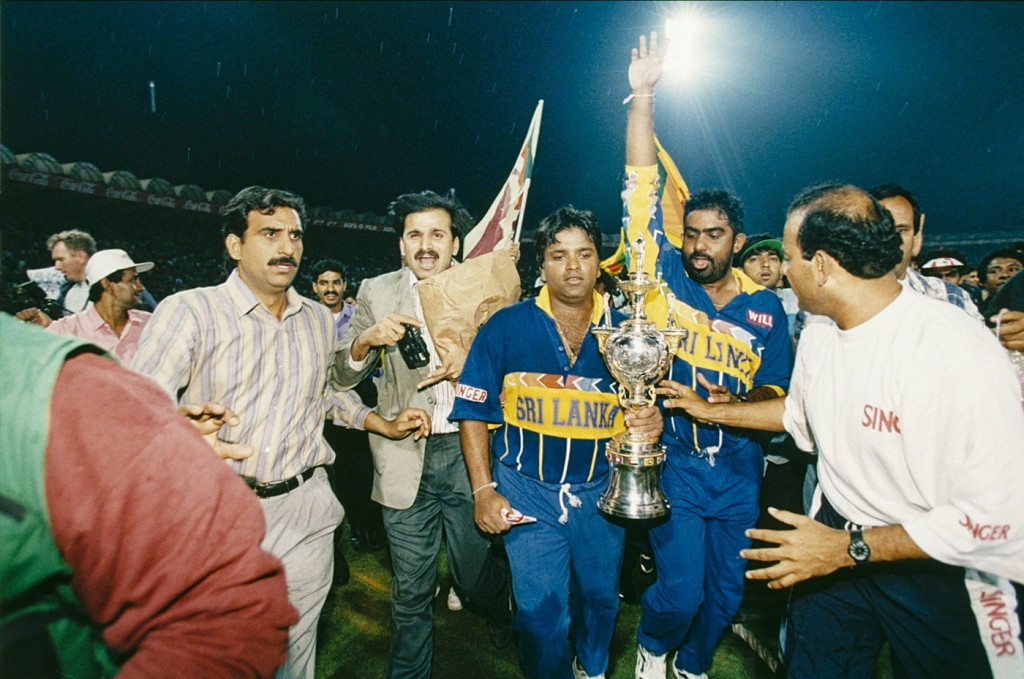
The 1996 cricket fiesta reached its quarterfinals with eight teams qualifying for the knockout stage. Unbeaten Sri Lanka, alongside Australia, India and West Indies confirmed their places from Group A. The South Africans, who remained undefeated from Group B, were followed by Pakistan, New Zealand and England. The cricketing giants were preparing for an enthralling showdown in yet another World Cup.
Jayasuriya Overwhelms England
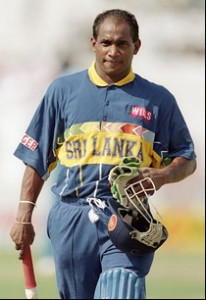
England, who were unable to beat a test nation in their group stage, were up against Sri Lanka for the first quarterfinals at Faisalabad on the 9th of March. Winning the toss, skipper Atherton elected to bat, hoping for a competitive total against Sri Lanka’s pinch-hitting onslaught. However wickets at regular intervals restricted English hopes as they ended up scoring 235/8 in 50 overs. The spinners took charge for Sri Lanka as Muralitharan, Jayasuriya and Dharmasena captured 2 wickets each while Phil DeFreitas reached his maiden ODI fifty, top scoring with 67.
The game was taken away by Jayasuriya’s opening ambush itself. Although Kaluwitharana was dismissed early, Jayasuriya continued his raid, especially targeting Illingworth, off whom he smashed four successive boundaries. DeFreitas’ 2 overs cost 32 as Jayasuriya needed only 44 deliveries to forge 82 with 13 fours and 3 massive sixes. By the time he was stumped by Jack Russell, it was certainly ‘game over’ for England. The total stood at 113/2 in 13 overs, virtually halfway to the target. With the initial damage done, the rest of the batsmen scored the remaining with 9 overs to spare. England ended their dreadful campaign, failing to qualify for a semi-final for the first time in history.
A Bitter End to a Thrilling Game
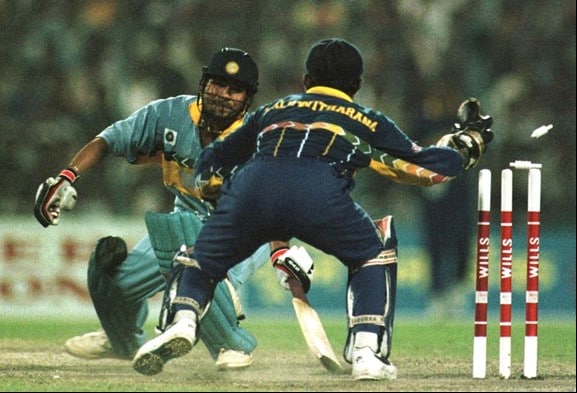
After a convincing victory against England, Sri Lanka met India who were returning from a heated affair against arch rivals Pakistan. Stakes were high as an estimated 120,000 passionate fans gathered to witness an exciting encounter at Eden Gardens on March 13th. Azharuddin won the toss and elected to field, perhaps to avert another Delhi chase. It was the perfect start for India as both openers Jayasuriya and Kaluwitharana were sent back to the pavilion in the first over. Gurusinghe soon followed but the determined Aravinda de Silva and Mahanama began to rebuild the innings. Aravinda rose to the occasion, scoring with ease, hammering 66 in 47 balls. Although hampered by wickets, Sri Lanka maintained a steady run rate of over 5. After Mahanama retired at 58 following a cramp, Ranatunga and Tillakaratne ensured that Sri Lanka would reach a competitive total of 251/8.
The target was gettable as Tendulkar led the response. With Tendulkar in command, the Indians were in a comfortable position at 98/1 but the turning point of the game was when he was stumped by Kaluwitharana for 65. The shift of momentum took a toll as the Indian batting line up collapsed like a house of cards, leaving them at 120/8 with Jayasuriya taking 3 for 12, two catches and a run out. The infuriated home crowd began to throw bottles and set fire to the seating as the Eden Gardens reached its boiling point. With an impossible 132 needed from 15.5 overs, and only two wickets in hand, match referee Clive Lloyd and the officials decided to award the match to Sri Lanka by ‘default’, as further resumption wasn’t possible, making it the only World Cup game to be called off.
West Indian Tragedy at Mohali
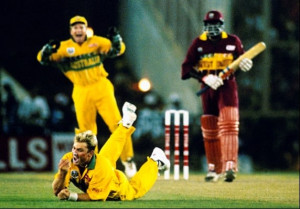
On the following day, Australia and West Indies played the remaining semi-final at PCA stadium, Mohali. Australia was in top form following Mark Waugh’s third ton which made a taxing run chase at Madras look so easy. West Indies, despite their humiliating defeat in the group stage, managed to knock favourites South Africa out of the tournament thanks to Lara’s majestic 111. However, the biggest tragedy was yet to hit them.
Batting first, Australia recovered from a strenuous 15/4 to post 207/8. Stuart Law and Michael Bevan spearheaded the recovery by scoring 72 and 69 respectively. A solid reply saw the Windies steaming at 165/2, needing 43 from the last nine overs. But Shane Warne stepped in to capture 3 quick wickets. Ultimately needing 6 from 5 balls with 2 wickets left; Ambrose was run out while Walsh was bowled by Damien Fleming. It was a stunning 5-run win for Australians, partly due to the needless panic by the West Indies.
Aravinda Delights, an Island Rejoices
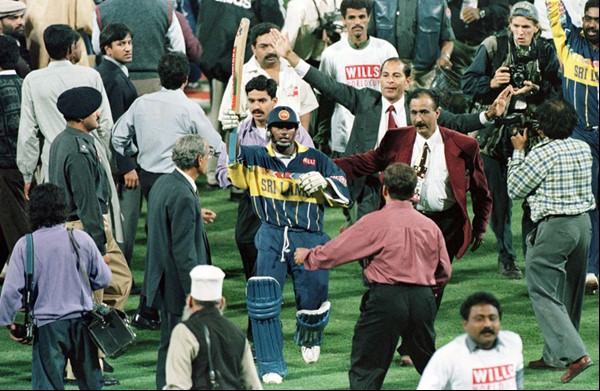
The two finalists graced Gaddafi Stadium, Lahore on the 17th of March as the scarcely-rated Sri Lankans faced the fancied powerhouse of Australia. Arjuna Ranatunga won the toss and decided to field first, hoping for early swing and considering the recent successful run-chases by his batsmen. It brought on much debate as no team had won a World Cup final batting second. The start by skipper Mark Taylor and Mark Waugh was impeded at 36 when danger-man Waugh was caught at square-leg by Jayasuriya. Ponting joined Taylor to cut the mustard with a 101-run stand, taking them to 137 at the end of 27 overs. Taylor was dismissed for a well-made 74 following an attempted sweep off de Silva’s spin, while Ponting too returned after his stumps were rattled by de Silva for 45. With two fresh batsmen in, the Sri Lankan spinners tightened their grip on the game. Boundaries dried up, as the scoreboard which read 110/1 after 20 overs, was reduced to 178/5 at the end of 40 overs. However, Bevan and Law’s late defiance kicked in, taking them to 241/7 in 50 overs.
In the second essay, the Aussies took the early charge as the pinch-hitting duo perished in quick time. Jayasuriya, who was already named the player of the tournament, was marginally run-out while Kaluwitharana was dismissed by Fleming for 6. But that was the end of the Australian influence as Aravinda de Silva joined Asanka Gurusinghe and turned the game around. With the dew playing a crucial role, the pair exploited the conditions as Gurusinghe was dropped on 53 at mid-wicket. Two further catches were also missed.
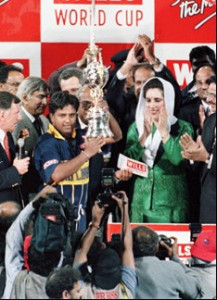
Aravinda’s delightful drives were reinforced by Gurusinghe’s ‘flat batting sensation’, which included a six off Warne’s bowling. Gurusinghe departed for 65 while the deputy was joined by his leader Ranatunga, who continued the assault with the pendulum having already swung in Sri Lanka’s favour. Needing 51 from the last ten, the little ‘Sri Lankans’ were all guns blazing. Aravinda, who came in at an onerous position, finally reached a well-deserved century. The 7-wicket victory was sealed in the 47th over as the skipper himself scored the winning runs with a late cut to the third-man boundary off McGrath. It was a glorious triumph as the Sri Lankans were crowned World Champions, merely 14 years after playing their first test match. Aravinda de Silva, who dominated the finals with 3 wickets, two catches and an unbeaten 107, was named man of the match.
Skipper Ranatunga received the Wills Trophy from the hands of Pakistani Premier Benazir Bhutto before hoisting it to the Lahore night sky, not only bringing momentous rejoice to a beautiful island nation, but also making a strong statement on the world of cricket.

